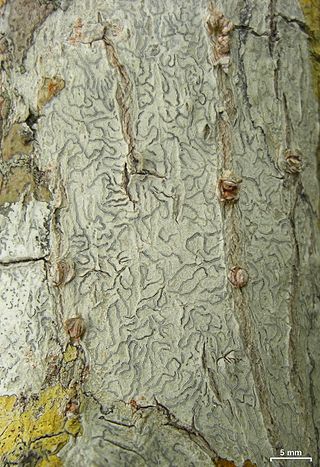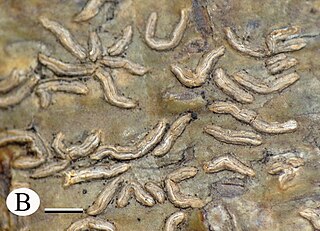
Ochrolechia is a genus of crustose lichens in the family Ochrolechiaceae.

Platygramme is a genus of lichen-forming fungi in the family Graphidaceae consisting of about 30 species. The genus was circumscribed by Antoine Laurent Apollinaire Fée in 1874.

Phaeographina is a genus of lichen-forming fungi in the family Graphidaceae. The genus was circumscribed by Swiss lichenologist Johannes Müller Argoviensis in 1882.

Fissurina is a genus of lichenized fungi in the family Graphidaceae. It has about 160 species, most of which are found in tropical regions.
A corticolous lichen is a lichen that grows on bark. This is contrasted with lignicolous lichen, which grows on wood that has had the bark stripped from it, and saxicolous lichen, which grows on rock.
Helge Thorsten Lumbsch is a German-born lichenologist living in the United States. His research interests include the phylogeny, taxonomy, and phylogeography of lichen-forming fungi; lichen diversity; lichen chemistry and chemotaxonomy. He is the Associate Curator and Head of Cryptogams and Chair of the Department of Botany at the Field Museum of Natural History.
Alan W. Archer is a mycologist and taxonomist. He is currently an honorary research associate at Royal Botanic Gardens Sydney. He uses chemotaxonomy as well as morphological features in taxonomy and to devise keys, most recently for the genus Pertusaria in the Australasia region.
Phaeographis salazinica is a species of script lichen in the family Graphidaceae. Found in the Solomon Islands, the lichen was first described as a new species in 2003 by Australian lichenologist Alan W. Archer. He named it Phaeographis salazinica, with the specific epithet referring to the presence of the compound salazinic acid as its major secondary compound. The lichen also contains trace amounts of consalazinic acid, connorstictic acid, norstictic acid, subnorstictic acid, protocetraric acid, and methyl norstictate. The type specimen was collected near Tatamba on Tanabuli Island. The main morphological characteristics of Phaeographis salazinica are the conspicuous lirellae, and the large brown muriform ascospores. Archer transferred the taxon to the genus Phaeographis in 2007.
Carbacanthographis salazinica is a species of script lichen in the family Graphidaceae. Found in Australia, it was described as a new species in 2001 by lichenologist Alan Archer. The type specimen was collected by Archer in Conglomerate State Forest. Here the lichen was found growing on the bark of a palm tree. Its thallus is thin and grayish-green, with conspicuous white lirellae measuring 1–4 mm long. The specific epithet refers to salazinic acid, the presence of which is a distinguishing characteristic of this species. The lichen also has trace amounts of other secondary chemicals, including consalazinic acid, norstictic acid, and protocetraric acid. In 2005 Archer transferred the taxon to genus Carbacanthographis.

Robert Lücking is a German lichenologist. He earned his master's and PhD from the University of Ulm, focusing on the taxonomy, ecology, and biodiversity of foliicolous lichens. He has received numerous awards for his work, including the Mason E. Hale Award for his doctoral thesis, the Augustin Pyramus de Candolle prize for his monograph, and the Tuckerman Award twice for his publications in the scientific journal The Bryologist. Since 2015, he has been serving as the curator of lichens, fungi, and bryophytes at the Berlin Botanical Garden and Botanical Museum. Several lichen species and a genus have been named in his honour.
Diaphorographis is a genus of lichen-forming fungi in the family Graphidaceae. It has two species. The genus was circumscribed in 2009 by lichenologists Alan W. Archer and Klaus Kalb, with D. queenslandica as the type species. The genus is distinguished from Graphis by the I− (iodine-negative) ascospores, and from Carbacanthographis) by the absence of periphysoids. Collectively, the genus is found in northern Queensland, New Caledonia, and the Solomon Islands. Although the genus was originally reported to not contain any lichen products, a later reexamination of the type species revealed the presence of protocetraric acid.
Pertusaria lueckingii is a species of corticolous (bark-dwelling), crustose lichen in the family Pertusariaceae. Found on the Galápagos Islands, it was formally described as a new species in 2015 by Frank Bungartz, Alan W. Archer, and John Elix. The type specimen was collected on Floreana Island, where it was found growing on the bark of a south-exposed trunk of Cedrella odorata. The species epithet honours German lichenogist Robert Lücking, "who first recognized this taxon as an independent species".
Pertusaria stictica is a species of corticolous and lignicolous, crustose lichen in the family Pertusariaceae. Found on the Galápagos Islands, it was formally described as a new species in 2015 by Fredy Nugra, Alan W. Archer, Frank Bungartz, and John Elix. The type specimen was collected at the border of the Galápagos National Park at an altitude of 471 m (1,545 ft), where in a secondary forest it was found growing on Psidium galapageium. The species epithet refers to stictic acid, a major metabolite in the lichen. It also contains trace amounts of constictic acid.
Pertusaria thioisidiata is a species of corticolous (bark-dwelling), crustose lichen in the family Pertusariaceae. Found on the Galápagos Islands, it was formally described as a new species in 2015 by Alba Yánez-Ayabaca, Frank Bungartz, Alan W. Archer, and John Elix. The type specimen was collected on the Alcedo Volcano at an altitude of 1,146 m (3,760 ft); there, on a southeast-exposed slope about 100 m (330 ft) below the rim of the crater, it was found growing on basalt. The species epithet refers to the presence of both isidia and the substance thiophaninic acid. The variety Pertusaria thioisidiata var. isidiogyrophorica contains gyrophoric acid rather than thiophaninic acid.
Pertusaria xanthoisidiata is a species of corticolous (bark-dwelling), crustose lichen in the family Pertusariaceae. Found on the Galápagos Islands, it was formally described as a new species in 2015 by Alan W. Archer, Frank Bungartz, and John Elix. The type specimen was collected on Pinta Island, where it was growing on an exposed trunk of Opuntia galapageia. The species epithet refers to the yellow-coloured isidia.
Pallidogramme is a genus of lichen-forming fungi in the family Graphidaceae. It has 8 species of corticolous (bark-dwelling), crustose lichens.

Fissurina insidiosa is a species of corticolous (bark-dwelling), script lichen in the family Graphidaceae. Found in the Southern Hemisphere, it has been recorded from mainland Australia, New Zealand, the Pacific region, the Caribbean, and India.
Fissurina elixii is a species of corticolous (bark-dwelling), script lichen in the family Graphidaceae. It is found in New South Wales and Tasmania in Australia.
Graphis stipitata is a species of corticolous (bark-dwelling) script lichen in the family Graphidaceae. Found in Australia, it was formally described as a new species in 2001 by the lichenologist Alan W. Archer. The type specimen was collected near Yungaburra Road in Queensland at an elevation of 850 m (2,790 ft), where it was found growing on the bark of Casuarina. The species epithet stipitata alludes to the numerous and crowded lirellae that are characteristic of this species. The lichen contains three secondary metabolites : lichexanthone as a major metabolite, norstictic acid as a minor component, and trace amounts of connorstictic acid.





